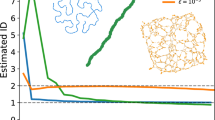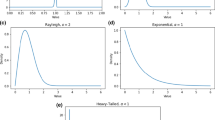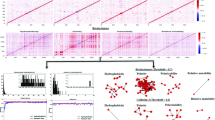Abstract
Many biological networks have been labelled scale-free as their degree distribution can be approximately described by a powerlaw distribution. While the degree distribution does not summarize all aspects of a network it has often been suggested that its functional form contains important clues as to underlying evolutionary processes that have shaped the network. Generally determining the appropriate functional form for the degree distribution has been fitted in an ad-hoc fashion.
Here we apply formal statistical model selection methods to determine which functional form best describes degree distributions of protein interaction and metabolic networks. We interpret the degree distribution as belonging to a class of probability models and determine which of these models provides the best description for the empirical data using maximum likelihood inference, composite likelihood methods, the Akaike information criterion and goodness-of-fit tests. The whole data is used in order to determine the parameter that best explains the data under a given model (e.g. scale-free or random graph). As we will show, present protein interaction and metabolic network data from different organisms suggests that simple scale-free models do not provide an adequate description of real network data.
Preview
Unable to display preview. Download preview PDF.
Similar content being viewed by others
References
Agrafioti, I., Swire, J., Abbott, J., Huntley, D., Butcher, S., Stumpf, M.P.H.: Comparative analysis of the Saccharomyces cerevisiae and Caenorhabditis elegans protein interaction networks. BMC Evolutionary Biology 5, 23 (2005)
Akaike, H.: Information measures and model selection. In: Proceedings of the 44th Session of the International Statistical Institute, pp. 277–291 (1983)
Albert, R., Barabási, A.: Statistical mechanics of complex networks. Rev. Mod. Phys. 74, 47 (2002)
Anderson, T.W., Darling, D.A.: Asymptotic theory of certain goodness-of-fit criteria based on stochastc processes. Ann.Math.Stat. 23, 193 (1952)
Anderson, T.W., Darling, D.A.: A test of goodness of fit. J.Am.Stat.Assoc. 49, 765 (1954)
Barabási, A., Albert, R.: Emergence of scaling in random networks. Science 286, 509 (1999)
Bollobás, B.: Random Graphs. Academic Press, London (1998)
Bollobás, B., Riordan, O.: Mathematical results on scale-free graphs. In: Bornholdt, S., Schuster, H. (eds.) Handbook of Graphs and Networks, pp. 1–34. Wiley-VCH, Chichester (2003)
Burda, Z., Diaz-Correia, J., Krzywicki, A.: Statistical ensemble of scale-free random Graphs. Phys. Rev. E 64, 46118 (2001)
Burnham, K., Anderson, D.: Model selection and multimodel inference: A practical information-theoretic approach. Springer, Heidelberg (2002)
Cox, D.R., Reid: A note on pseudolikelihood constructed from marginal densities. Biometrika 91, 729 (2004)
Davison, A.: Statistical models. Cambridge University Press, Cambridge (2003)
Dorogovtsev, S., Mendes, J.: Evolution of Networks. Oxford University Press, Oxford (2003)
Dorogovtsev, S., Mendes, J., Samukhin, A.: Multifractal properties of growing networks. Europhys. Lett. 57, 334 (2002); cond–mat/0106142
Ito, T., Tashiro, K., Muta, S., Ozawa, R., Chiba, T., Nishizawa, M., Yamamoto, K., Kuhara, S., Sakaki, Y.: Towards a protein-protein interaction map of the budding yeast: A comprehensive system to examine two-hybrid interactions in all possible combinations between the yeast proteins. PNAS 97, 1143 (2000)
Maslov, S., Sneppen, K.: Specificity and stability in topology or protein networks. Science 296, 910 (2002)
May, R., Lloyd, A.: Infection dynamics on scale-free networks. Phys. Rev. E 64, 66112 (2001)
Newman, M., Strogatz, S., Watts, D.: Random graphs with arbitrary degree distribution and their application. Phys. Rev. E 64, 026118 (2001); cond–mat/0007235
Qin, H., Lu, H., Wu, W., Li, W.: Evolution of the yeast interaction network. PNAS 100, 12820 (2003)
Strimmer, K., Rambaut, A.: Inferring confidence sets of possibly misspecified gene trees. Proc. Roy. Soc. Lond. B 269, 127 (2002)
Stumpf, M.P.H., Wiuf, C., May, R.M.: Subnets of scale-free networks are not scale-free: the sampling properties of random networks. PNAS 103, 4221 (2005)
Wagner, A.: The yeast protein interaction network evolves rapidly and contains few redundant duplicate genes. Mol. Biol. Evol. 18, 1283 (2001)
Xenarios, I., Rice, D., Salwinski, L., Baron, M., Marcotte, E., Eisenberg, D.: Dip: the database of interacting proteins. Nucl. Acid. Res. 28, 289 (2000)
Yook, S., Oltvai, Z., Barabási, A.: Functional and topological characterization of protein interaction networks. Proteomics 4, 928 (2004)
Author information
Authors and Affiliations
Editor information
Editors and Affiliations
Rights and permissions
Copyright information
© 2005 Springer-Verlag Berlin Heidelberg
About this paper
Cite this paper
Stumpf, M.P.H., Ingram, P.J., Nouvel, I., Wiuf, C. (2005). Statistical Model Selection Methods Applied to Biological Networks. In: Priami, C., Merelli, E., Gonzalez, P., Omicini, A. (eds) Transactions on Computational Systems Biology III. Lecture Notes in Computer Science(), vol 3737. Springer, Berlin, Heidelberg. https://doi.org/10.1007/11599128_5
Download citation
DOI: https://doi.org/10.1007/11599128_5
Publisher Name: Springer, Berlin, Heidelberg
Print ISBN: 978-3-540-30883-6
Online ISBN: 978-3-540-31446-2
eBook Packages: Computer ScienceComputer Science (R0)




